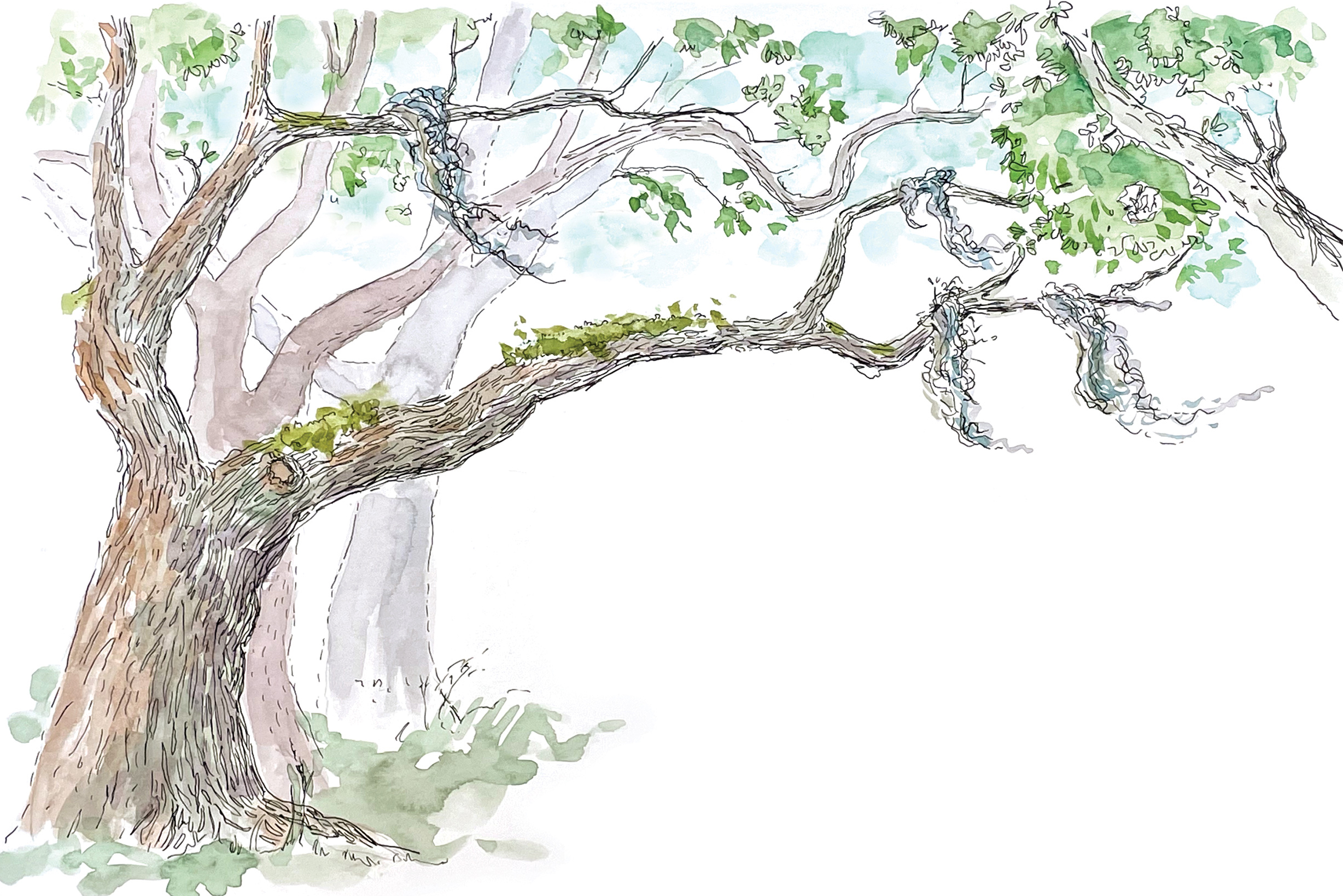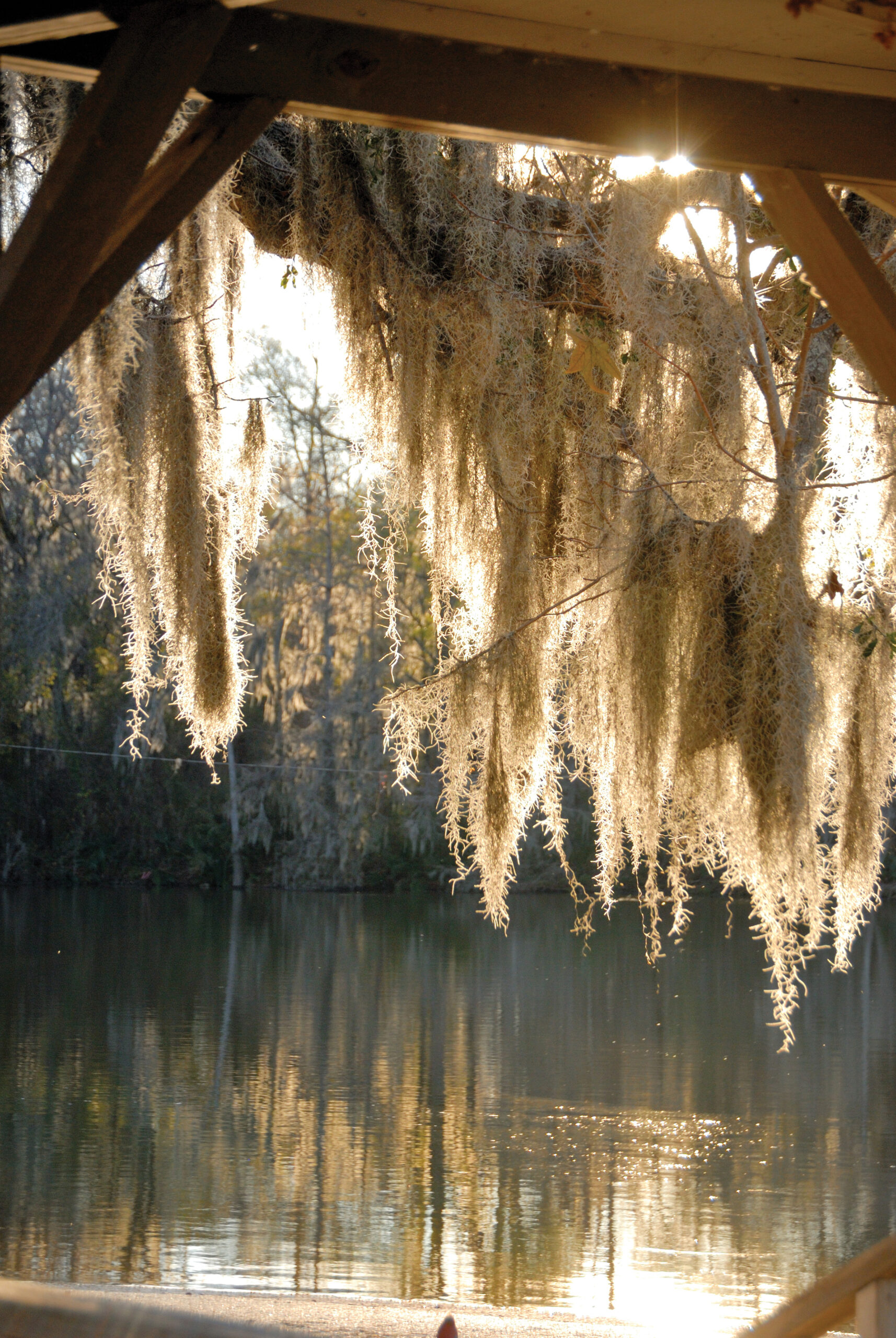
For centuries, Spanish moss has been misunderstood. My Sunday school teacher worried that it was draining the life of her trees, and no matter how hard she tried, she could never fully rid herself of it. She’s one of many who has mistakenly believed it to be a parasite. The beard-like mass isn’t even a moss, but an epiphytic air plant that takes its nutrients from the environment rather than from its host — nutrients that mostly exist in humid tropical and subtropical climates like the South. It prefers creating shade rather than growing in it, and it only thrives in places where the air is clean. It is also a willful plant that grows where it pleases. My teacher should have been honored that it chose to take residence in her live oaks and crape myrtles, but maybe she was afraid of what might be hiding in it.
Spanish moss is an effective blind for wildlife. Frogs, spiders and bats take refuge in larger mats, and varieties of destructive insects are commonly found in clusters of all sizes. Notably, not chiggers. At least not in the stuff in the trees. Spanish moss usually hangs too high for the low-lying mites. It’s the tufts that fall to the earth and grow at a child’s eye level that harbor the red pests, which is why my mother would be filled with dread when I put it on my head as a child and pretended to be a witch. At least the clumps I picked off the ground never had rat snakes in them.
People have also found uses for Spanish moss beyond shade and floral arrangements. Early Houma and Seminole indigenous tribes used it to treat fevers and high blood pressure, construct garments, frame and insulate houses, braid rope, seal canoes and skim fat during cooking. Confederate soldiers wove it into blankets and saddle pads. In the early 20th century, Henry Ford used it to pad car seats until vehicles were recalled due to insect infestations that resulted in riders being covered in bug bites.
Spanish moss also has ineffable, inherently mythical qualities. There’s a reason it’s such a presence in literature and films set in the Deep South. It plays different characters depending on the time of day. It’s a regal creature during the golden hour right after a summer storm — the way it looks silhouetted by the sunlight it diffracts, casting rays into the mist billowing off the asphalt. On dark October nights, it has more sinister features. It’s no wonder that indigenous, colonial, Spanish and Hawaiian folklore ties the tangled plant to death and curses. As dark as shadows can paint Spanish moss, myths have unfairly maligned it.
We are blessed to have such an abundance of the plant skirting Mobile Bay, but it’s not as ubiquitous as it once was, and it doesn’t grow on every tree. One of my poor neighbors who loves the romance of mussed knots hanging off a tree bough is sandwiched between two houses overwhelmed by it, yet the trees in her front yard remain bare. She tried to coax it into growing on her limbs, draping clumps from donor colonies on the branches she could reach. It never took, which she found rather insulting. It should be quite easy to grow in the right conditions. She eventually conceded defeat, but I have seen her in her yard a few times tossing dried Spanish moss from a Hobby Lobby bag onto her crape myrtle trees until it catches and hangs off only the tips of the limber young branches. It’s just for special occasions.

There are knowns and mysteries to Spanish moss. We know what conditions they need to exist. Sunlight, humidity and clean air should do it. Generally, it prefers trees like live oaks because the limbs are easy to latch onto and they release higher levels of minerals particularly conducive to growing. Yet, even if all necessities are met, it is not guaranteed to obey nature. No one fully understands why Spanish moss refuses to grow on trees it should, or why it would ever settle for power lines over cypresses.
You can see the plant’s finickiness in the Bellingrath Gardens and Home parking lot. Most of the trees have sprawling, heavy limbs nearly overburdened with Spanish moss, but a few naked ones hide among them. There doesn’t appear to be any significant differences between the bare and ornamented oaks. It could be that some are younger and exhale less minerals than their elders. Maybe the bare ones are shaded. It’s also possible that clumps that may have once been there could no longer survive the changing environment. It’s happening to neighborhoods across the Bay area.
Pollution is an unfortunate side effect of industrial and societal progress, and an air plant cannot thrive in an environment that suffocates it. The contaminated particles it absorbs slowly poison it. The polluted rain it stores under its imperceptible scales delivers a second blow to its health. Lifelong Mobile Bay residents have watched the population dwindle. They can walk through historic districts and point to unadorned trees that once wore drapes of Spanish moss. As tragic as the loss is, it is also our canary in a coal mine. The contamination that plagues it also fills our lungs, and what kills a being made to purify the air will certainly assault our bodies only designed to absorb it. The life and death of Spanish moss is a message to us. We should be grateful for its sacrifice and take heed of its warning. It’s the hair of a good witch.
I don’t make a habit of putting Spanish moss on my head now, but Momma’s come around to seeing the beauty of it so long as it stays in the trees. It still makes my heart flutter when I drive down Springhill Avenue at sunset or walk along the bayfront in Fairhope on a windy day in late spring. When I travel away from the Gulf Coast, I know I’m getting close to home when I start seeing Spanish moss in the trees. It’s part of our heritage and our character and the stories that we tell. It’s a part of who we are.





